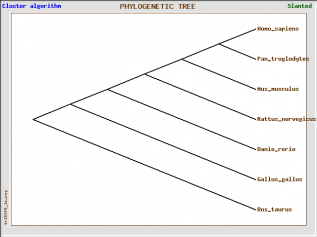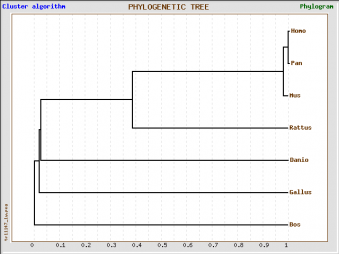This web page was produced as an assignment for Genetics677, an undergraduate course at UW-Madison.
Protein homology
Following information retrieved from HomoloGene
List of homologues:
BMPR2, Pan troglodytes XP_001172748.1
1033 amino acids
BMPR2, Bos taurus XP_617592.4
914 amino acids
Bmpr2, Mus musculus NP_031587.1
1038 amino acids
BMPR2, Rattus norvegicus XP_217409.4
1028 amino acids
BMPR2, Gallus gallus NP_001001465.1
1031 amino acids
Bmpr2b, Danio rerio NP_001034896.1
1071 amino acids
The result of protein alignment can be found here
Following data retrieved from BLAST
Using BLAST, I found how protein of BMPR2 is conserved throughout different species.
Here is what I found :
Pan troglytes
Identities=1037/1038 (99%) Positive=1037/1038 (99%)
Bos taurus
Identities=871/902 (96%) Positive=884/902 (98%)
Mus musculus
Identities=1003/1038 (96%) Positive=1019/1038 (98%)
Rattus norvegicus
Identities=934/1038 (89%) Positive=969/1038 (93%)
Gallus gallus
Identities=918/1024 (89%) Positive=956/1024 (93%)
Danio rerio
Identities=713/1081 (65%) Positive=808/1081 (74%)
Based on my obtained results from BLAST, Pan troglodytes is the most closest animal to human based on BMPR2 protein alignment. Danio rerio is the least closest animal to human based on BMPR2 protein alignment. In addition, Mus musculus is about 98% positively correlated. Mouse would be a good candidated organism model with my experiment due to highly aligned BMPR2 protein with human's and easy maninulating characteristic. In addition, there are many reseraches with mouse, therefore, it would be great to compare with my data results. As a overall analysis, the protein is well conserved throughout the branch of species.
Protein phylogeny
Following figures retrieved from GeneBee
I used two programs to generate phylogenic tree of the protein from BMPR2. I was able to use the full length of protein for both analyses. It was interesting the there were many different types of phylogenic tree could be made with same order. Depending on types of tree, I could choose which one would represent the correlation between organisms well. Therefore, I am posting above two trees that represent well. First figure shows which organisms are related by separating at each node. According to the result, Pan tryglodytes is the closest organism to Homo sapiens because they are separating at last node. Second figure shows same order of relatedness as the first figure. However, the degree of relatedness is represented with the length of each connected line. From this result, we can consider to study or to conduct with Pan tryglodytes about pulmonary arterial hypertension. Mus Musculus is another good candidate organism to have experiment to understand the mechanism of mutated BMPR2 and pulmonary arterial hypertension.
The data I obtained in a phylogenic tree form is highly correlated with the data from Homologene. As I've mentioned previously, Pan tryglodytes is the most closest organism, while the Danoi rerio is the least closest organism.
Following figure retrieved from Treefam
The data I obtained in a phylogenic tree form is highly correlated with the data from Homologene. As I've mentioned previously, Pan tryglodytes is the most closest organism, while the Danoi rerio is the least closest organism.
Following figure retrieved from Treefam
The result obtained from Treefam is categorized into different kinds of proteins under same protein family that BMRP2 is belong to. The order of relatedness for each protein is fairly similar. Homo sapiens is mostly related to Pan tryglodytes then to Mus musculus. Even though the phylogenic tree that was creased by Treefam is very long, I think it will be very useful information for future study, such as analyzing protein interaction in different species. By analyzing for each proteins under same protein family, it will be more accurate and reliable data.



